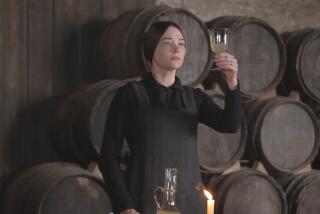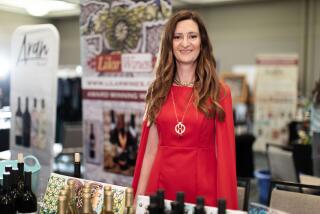Armagnac: The Autumnal Spirit
- Share via
Nowhere do place and product marry so definitively as in Gascony in autumn, when foie gras, bold wines, wild mushrooms and well-fed game spill from farms and forests. At that season, Gascony is like a magnificent stage set for a swashbuckling pageant complete with plumed chapeaux and springy rapiers.
Orderly rows of golden autumnal vines unfurl across a panorama of rolling hills. The ochre stone walls of an isolated chateau rise above a grove of old oaks and gnarled cypresses in a well-kept but silent park. Beside it, a stone barn nurses hundreds of barrels of brandy, slowly aging in darkness and silence.
Outside, lofty clouds sweep across intense blue skies. At any time, a dark gray Atlantic squall may sweep through, drenching the sun-warmed land.
It seems that everyone here speaks of the local brandy as the main character in the pageant. Armagnac becomes the lusty poetry of southwestern France, distilled into a rustic elixir that graces fine restaurant and farmhouse tables alike.
A farmer in a flat Gascon beret drops some of his best Armagnac into roughened palms and rubs them together before plunging his nose into his hands and inhaling deeply. A cellar master’s face lights up as he describes the aromas that linger on his palate after a taste from a tulip-shaped glass. A restaurateur becomes a philosopher, stretching the idea of flavor to define a newly discovered complexity as he describes deglazing spitting-hot pans with the potent spirit of Gascony.
To know Armagnac the brandy, it is essential to know Armagnac the area, which is divided into Haut Armagnac, Bas Armagnac and Tenareze. Here, moderated by the snow-crested Pyrenees to the south and the warm marine influence of the Atlantic, the grapes--Ugni Blanc, Folle Blanche, Baco, Piquepoul and Colombard--produce a light wine generally of less than 10% alcohol. This is the wine that is most often distilled and transformed into l’eau ardente or l’eau bru^lantea, the ardent or burning water.
The Bas Armagnac area, to the west, has a soil blended of clay and fine sand called sable fauve, which gives its wines their famous plum-prune fragrance, as ripely fruity as summer jam. The heart of Armagnac is Tenareze, defined by its clay and limestone soil, which makes for heady wines perfumed with violet. The Haut Armagnac, lying to the east, cradles its more prestigious neighbors in limestone arms. Its chalky soil is mainly reserved for table wine production.
In Tenareze, a country road about as wide as a driveway leads to the vineyards and distillery of the Kauffer family at Domaine de Cazeaux. The Kauffers use a traditional copper alambic still. Formerly drawn by horse from farm to farm on giant wooden wheels, this lovingly preserved family heirloom, polished and gleaming golden-red, still makes the family’s entire production.
As if explaining to a child the basics of an easy game, Kauffer, retired mayor of Lannes, describes in simply phrased French the dynamics of the alambic Armagnacais. Rube Goldberg would have been impressed:
A current of the wine produced in adjoining rooms is steadily warmed, then tumbles down successive layers of trays until it rests above a flame, which converts it to steam and vaporized alcohol. The alcohol and all its aromas and esters bubble back up through each tray of wine. In some alambics, there are as few as five, in others as many as 14.
The descending wine charges and recharges the vapor as it bubbles up toward the crooked copper neck that leads to the serpentine coil. The coil descends through the first wine chamber, warming the incoming wine and cooling the outgoing vapors.
This clever manipulation of copper tubing produces a complex distillation rich in aroma, with a great aptitude for aging. Though often described as “rustic,” Armagnac is, in fact, very smooth and complex with nuances of flavor that fill the nose and mouth.
The clear new brandy is left to evolve in vanilla-scented new oak barrels, known as pieces, for two years or so. There it slowly deepens in color until it attains the characteristic honey-amber hue of Armagnac.
Successive years of barrel aging follow, using older and less aggressively fragrant wooden barrels. The Armagnac may age in wood for six, 10, 20 or even 40 years before it’s ready for bottling. Various barrels are blended to make the various grades of Armagnac: hors d’a^ge, Napoleon, XO, VSOP, and trois etoiles. Each designation is determined by the youngest Armagnac used in the blend.
Stellar vintages of Armagnac, prized for their unique flavors, are also aged separately. Aged in wood until deemed ready (perhaps a generation later), a vintage Armagnac is bottled and labeled with both the year of its vintage and the date of bottling.
As it ages, the brandy slowly evaporates through the wood of the barrels, modifying the alcohol content and concentrating the flavor. For a small producer, as much as a season’s worth of sales can evaporate through the oak barrels, through the roof of the chai and into the soft Gascon sky. This is the portion referred to as la parte des anges, the angels’ share.
The loss in quantity is compensated by celestial quality. The red-tiled roof of the lofty stone barn in which these wines age is darkened by an alcoholic fungus that feeds on this ethereal repast. It is nearly as black as soot and exudes its own heady aroma of vanilla and honey.
In Bas Armagnac, Max DeMolie is cellar master of Cha^teau de Sandemagnan, situated between Eauze and Cazaubon. Owned by Michel and Christine Guerard, a three-star restaurateur and his equally talented designer wife, the 100-year-old chai still stocks the last 30 years of production at the property once owned by Christine Guerard’s father.
When pressed to describe his Armagnac, the expressive young mai^tre de chai speaks of cooked plums, adding that to the impressive litany heard across the Armagnac country: quince jelly, white peaches, cassis, prunes, pepper, vanilla, dusty wood, cinnamon, clove, green tobacco, wet metal, roses, wet leaves, apple seed, orchid, lily, licorice, sugar, honey, cocoa, roasted grapes, cocoa butter and salt.
At the nearby distillery, the new copper still has a panel of modern gauges that help regulate the delicate gas fire. Too much flame and the result is harsh and biting; too little and the Armagnac is weak and flat. Guerard adds his own touch to the final product by aging mature Armagnac in smaller barrels from his Tursan winery. “The result is a more feminine and delicate touch,” DeMolie says. “More finesse.”
In the elegant dining room of Les Pres d’Eugenie, his restaurant in Eugenie-les-Bains, Guerard searches for the definitive poetry to describe Armagnac; how it’s made, how it’s aged and how it’s consumed. “It was only after I began to explore wine- and Armagnac-making that I understood aromatic complexity,” he says. “In the kitchen we can orchestrate taste to our own end, not just sweet, salty, acid and bitter but textures, soft or crisp.
“But in the winery and in the fields, nature makes the decisions. The chance elements of sun, rain and climate are a good antidote against getting a fat head.
“Winemaking brings me a lot of pleasure,” he says, grinning, “but it also brings a new humility to us who are in this world of the kitchen. It has taught me patience and given me a new identity to cultivate. Making Armagnac keeps me modest.”
Ratliffe lives in southwest France on her 80-year-old canal barge.
More to Read
Eat your way across L.A.
Get our weekly Tasting Notes newsletter for reviews, news and more.
You may occasionally receive promotional content from the Los Angeles Times.







